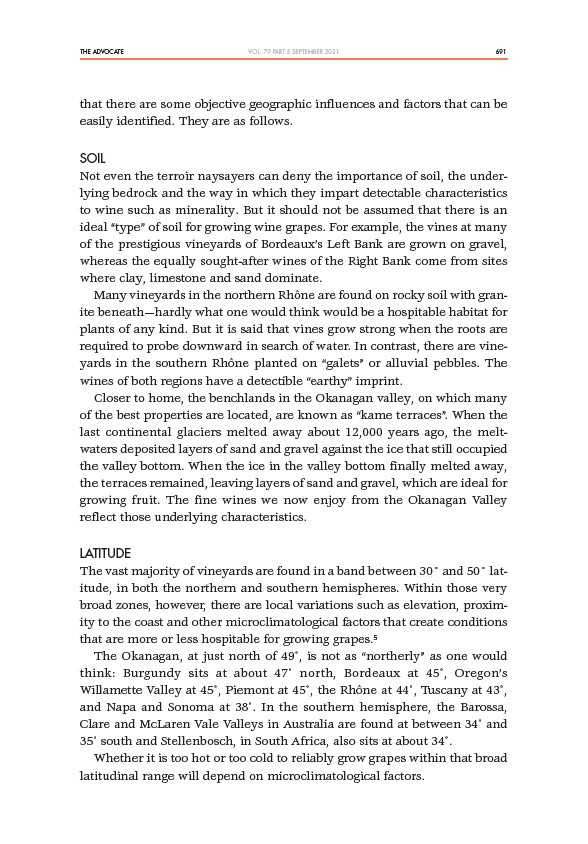
THE ADVOCATE 691
VOL. 79 PART 5 SEPTEMBER 2021
that there are some objective geographic influences and factors that can be
easily identified. They are as follows.
SOIL
Not even the terroir naysayers can deny the importance of soil, the underlying
bedrock and the way in which they impart detectable characteristics
to wine such as minerality. But it should not be assumed that there is an
ideal “type” of soil for growing wine grapes. For example, the vines at many
of the prestigious vineyards of Bordeaux’s Left Bank are grown on gravel,
whereas the equally sought-after wines of the Right Bank come from sites
where clay, limestone and sand dominate.
Many vineyards in the northern Rhône are found on rocky soil with granite
beneath—hardly what one would think would be a hospitable habitat for
plants of any kind. But it is said that vines grow strong when the roots are
required to probe downward in search of water. In contrast, there are vineyards
in the southern Rhône planted on “galets” or alluvial pebbles. The
wines of both regions have a detectible “earthy” imprint.
Closer to home, the benchlands in the Okanagan valley, on which many
of the best properties are located, are known as “kame terraces”. When the
last continental glaciers melted away about 12,000 years ago, the meltwaters
deposited layers of sand and gravel against the ice that still occupied
the valley bottom. When the ice in the valley bottom finally melted away,
the terraces remained, leaving layers of sand and gravel, which are ideal for
growing fruit. The fine wines we now enjoy from the Okanagan Valley
reflect those underlying characteristics.
LATITUDE
The vast majority of vineyards are found in a band between 30° and 50° latitude,
in both the northern and southern hemispheres. Within those very
broad zones, however, there are local variations such as elevation, proximity
to the coast and other microclimatological factors that create conditions
that are more or less hospitable for growing grapes.5
The Okanagan, at just north of 49°, is not as “northerly” as one would
think: Burgundy sits at about 47° north, Bordeaux at 45°, Oregon’s
Willamette Valley at 45°, Piemont at 45°, the Rhône at 44°, Tuscany at 43°,
and Napa and Sonoma at 38°. In the southern hemisphere, the Barossa,
Clare and McLaren Vale Valleys in Australia are found at between 34° and
35° south and Stellenbosch, in South Africa, also sits at about 34°.
Whether it is too hot or too cold to reliably grow grapes within that broad
latitudinal range will depend on microclimatological factors.